Arm Announces Mobile Armv9 CPU Microarchitectures: Cortex-X2, Cortex-A710 & Cortex-A510
by Andrei Frumusanu on May 25, 2021 9:00 AM EST- Posted in
- SoCs
- CPUs
- Arm
- Smartphones
- Mobile
- Cortex
- ARMv9
- Cortex-X2
- Cortex-A710
- Cortex-A510
New DSU-110 L3 & Cluster: Massively More Bandwidth
Alongside the new CPU microarchitectures, Arm today is also announcing a new L3 design in the form of the new DSU-110. The “DynamIQ Shared Unit” had been the company’s go-to cluster and “core complex” block ever since it was introduced in 2017 with the Cortex-A75 and Cortex-A55. While we’ve seen small iterative improvements, today’s DSU-110 marks a major change in how the DSU operates and how it promises to scale up in cache size and bandwidth.
The new DSU-110 is a ground-up redesign with an emphasis on more bandwidth and more power efficiency. It continues to be the core building block for all of Arm’s mobile and lower tier market segments.
A key metric is of course the increase of L3 cache configuration which will now go up to 16MB this generation. This is of course the high-end of the spectrum and generally we shouldn’t expect such a configuration in a mobile SoC soon, but Arm has had several slides depicting larger form-factor implementations using such a larger design housing up to 8 Cortex-X2 cores. This is undoubtedly extremely interesting for a higher-performance laptop use-case.
The bandwidth increase of the new design is also significant, and applies from single-thread to multi-threaded scenarios. The new DSU-110 promises aggregate bandwidth increases of up to 5x compared to the contemporary design. More interesting is the fact that it also significantly boosts single-core bandwidth, and Arm here actually notes that the new DSU can actually support more bandwidth than what’s actually capable of the new core microarchitectures for the time being.
Arm never really disclosed the internal topology of the previous generation DSU, but remarks that with the DSU-110 the company has shifted over to a bi-directional dual-ring transport topology, each with four ring-stops, and now supporting up to 8 cache slices. The dual-ring structure is used to reduce the latencies and hops between ring-stops and in shorten the paths between the cache slices and cores. Arm notes that they’ve tried to retain the same lower access latencies as on the current generation DSU (cache size increases aside), so we should be seeing very similar average latencies between the two generations.
Parallel access increases for bandwidth as well as more outstanding transactions seem to have been also very important in order to improve performance, which seems very exciting for upcoming SoC designs, but also puts into more question the previously presented CPU IPC improvements and exactly how much the new DSU-110 contributes to those numbers.
Architecturally, one important change to the capabilities of the DSU-110 is support for MTE tags, a upcoming security and debugging feature promising to greatly help with memory safety issues.
The new DSU can scale up to 4x AMBA CHI ports, meaning we’ll have up to 1024-bit total bi-directional bandwidth to the system memory. With a theoretical DSU clock of around 2GHz this would enable bandwidth of up to 256GB/s reads or writes, or double that when combined, plenty enough to be able to saturate also eventual high-end laptop configurations.
In terms of power efficiency, the new DSU offers more options for low-power operation when in idle situations, implementing partial L3 power-down, able to reduce leakage power of up to 75% compared to the current DSU.
In general idle situations but still having the full L3 powered on, the new design promises up to 25% reduction in leakage power all whilst offering 2x the bandwidth capabilities.
It’s important to note that we’re talking about leakage power here- active dynamic power is expected to generally scale linearly with the bandwidth increase of the new design, meaning 5x the bandwidth would also cost 5x the power. This would be an important factor to note into system power and in general the expected power behaviour of the next-gen SoCs when they’re put under heavy memory workloads.
Arm describes the DSU-110 as the backbone of the Armv9 cluster and that seemingly seems to be an apt description. The new bandwidth capabilities are sure to help out both with single-threaded, but also with multi-threaded performance of upcoming SoCs. Generally, the new 16MB L3 capability, while it’s possible somebody might do a high-end laptop SoC configuration, isn’t as exciting as the now finally expected move to a new 8MB L3 on mobile SoCs, hopefully also enabling higher power efficiency and more battery life for devices.


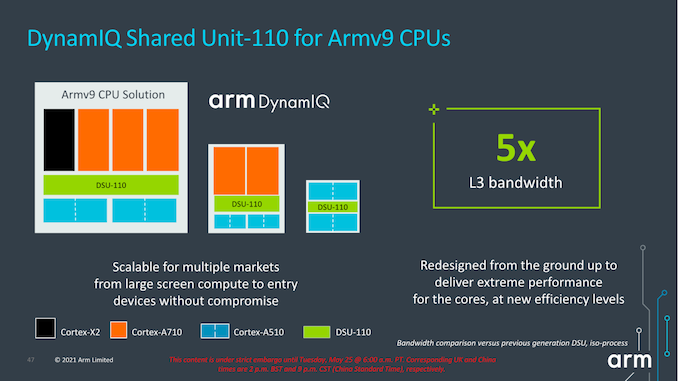
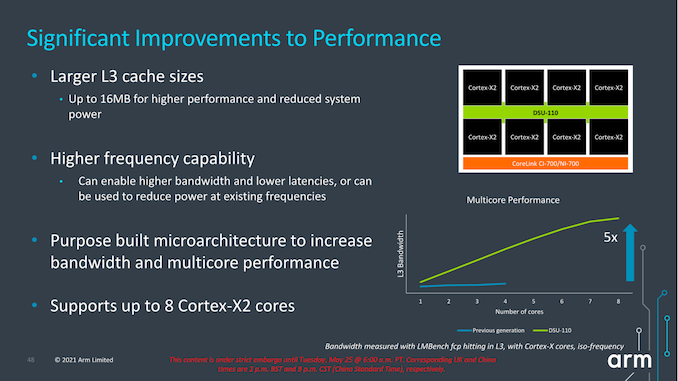
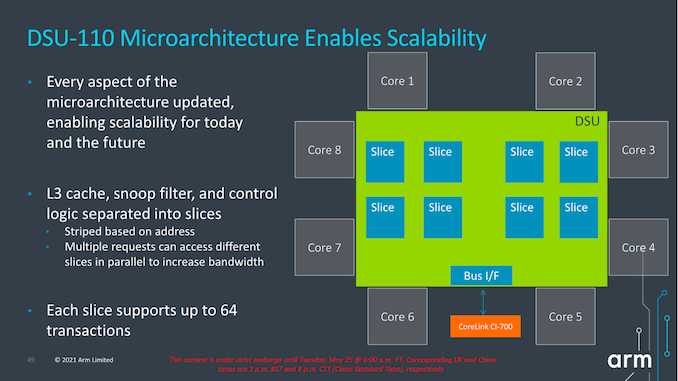
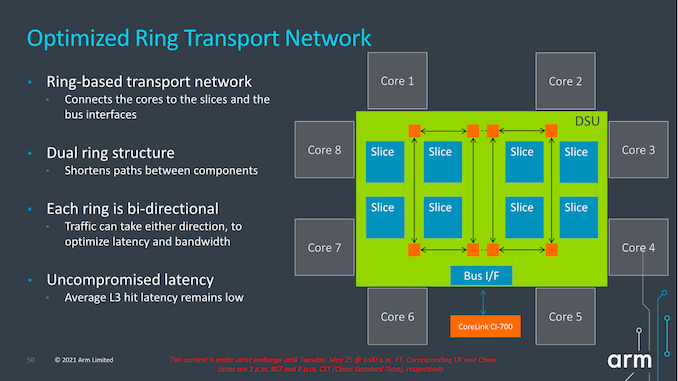
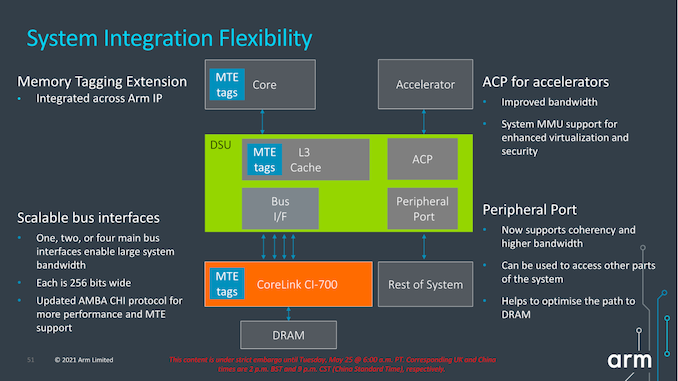

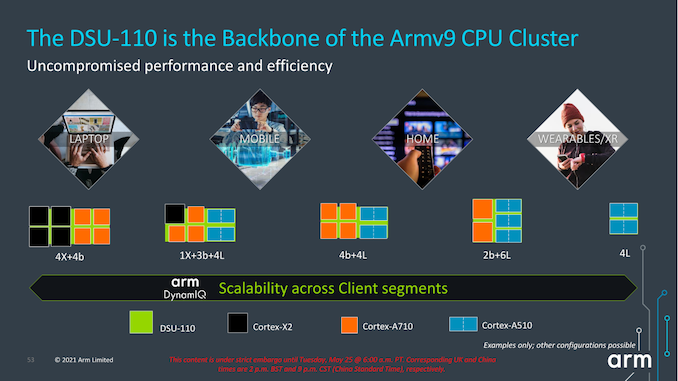








181 Comments
View All Comments
Fulljack - Wednesday, May 26, 2021 - link
that's why it's called DynamIQ, you know... as in "dynamic".phoenix_rizzen - Tuesday, May 25, 2021 - link
Interesting. Wonder if Samsung and/or Qualcomm will be using the A510 as the basis for a smartwatch SoC. A pair of these should provide a huge performance increase over the A7-based SoCs, but use much less power than anything using a "big" core (wasn't there a Samsung watch SoC that used a big core?).EthiaW - Tuesday, May 25, 2021 - link
An ideal mobile SoC configuration should be 2xX2+4xA710+2xA510. There is only so much background work to do and as many as four little cores do not make sense.Fulljack - Wednesday, May 26, 2021 - link
I'm thinking of 1×X2 + 3×A710 + 2×A510, and gives more room for GPU.docola - Tuesday, May 25, 2021 - link
question: does this mean if i buy a mobile phone today,that starting within a year from now it will eventually be useless because all
apps will be moving to 64 bit, which my phone wont support?
Or will my phone have access to plenty of the man 32 bit apps for 3-4 years to come?
(if thats the cas then i think i'll buy a stupidly cheap phone till next year)
thanks~
phoenix_rizzen - Tuesday, May 25, 2021 - link
Android phones have supported 64-bit OSes and apps since the Snapdragon 810, many many years ago.Android stopped accepting new 32-bit apps into the Play Store in 2019.
Android has essentially been 64-bit only for over 2 years now.
mode_13h - Wednesday, May 26, 2021 - link
> Android phones have supported 64-bit OSes and apps since the Snapdragon 810,> many many years ago.
You mean 8xx. I got a Nexus 5X in like 2015 that had a Snapdragon 808 with 2x A57 and 4x A53.
docola - Tuesday, May 25, 2021 - link
does the shift to 64 bit apps mean that todays phonewill start being unable to run apps next year?
Wilco1 - Tuesday, May 25, 2021 - link
No. Pretty much all phones are 64-bit today and thus support 64-bit apps already.Silver5urfer - Tuesday, May 25, 2021 - link
What's the use when all of these end up in planned obsolescence devices which have a max life of 2-3 years. They should make this "Days charging" whatever into reality by making the phones with removable batteries.As for laptops, same thing but different skin. Most of the BGA laptops will die fast because of their Heatsink and non replaceable components and high heat due to thin and light designs (mostly for x86) and then the Batteries for all those machines after market there's no way anyone can make use of their HW for more years, esp if the HW is all soldered. For eg an MXM laptop can take many generations of the GPUs it used to be the case for most machines until now since nowadays Turing based GPUs Quadro cards are also non standard.
So all in all get excited for same performance benefits that user will see, my SD835 phone is quick and fast and reliable yeah SD888 would be definitely faster but how much it would impact in the normal tasks of Maps / Browser / Videos / Music ? Games maybe but I don't play on smartphones. I presume it is same for all those SD855, 865 phones. Even the iPhones from A11 and up.
Bonus we don't get to control even 1 bit with hardcore locks on phones from OS level Filesystem nerfs from Goolag to the HW side of having no 3.5mm jacks and SD slots. But yea people love to get excited for new shiny stuff.